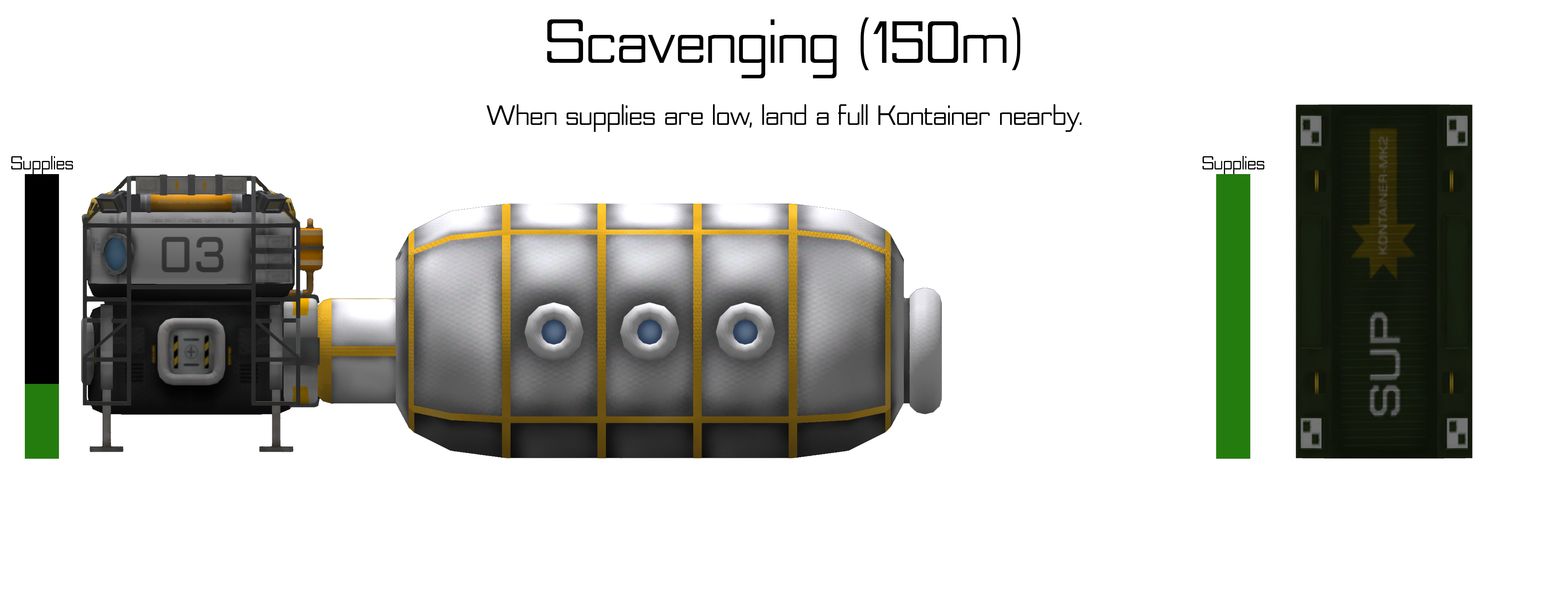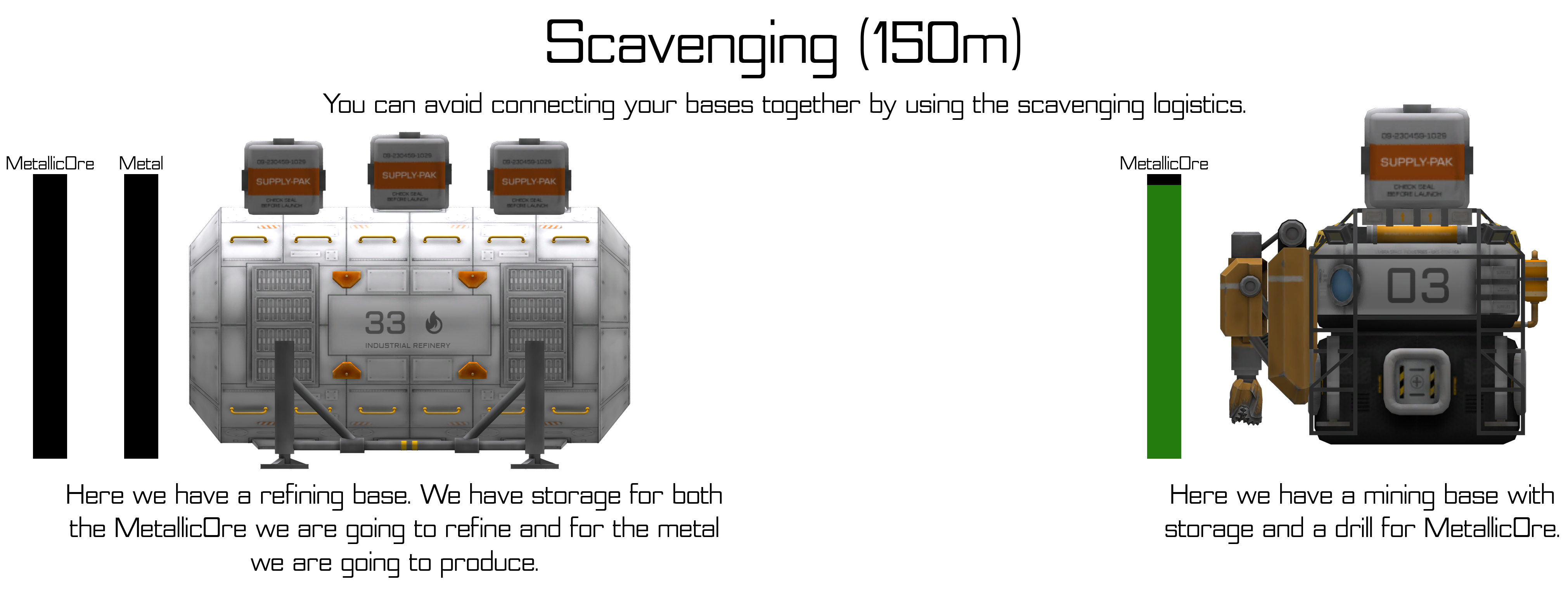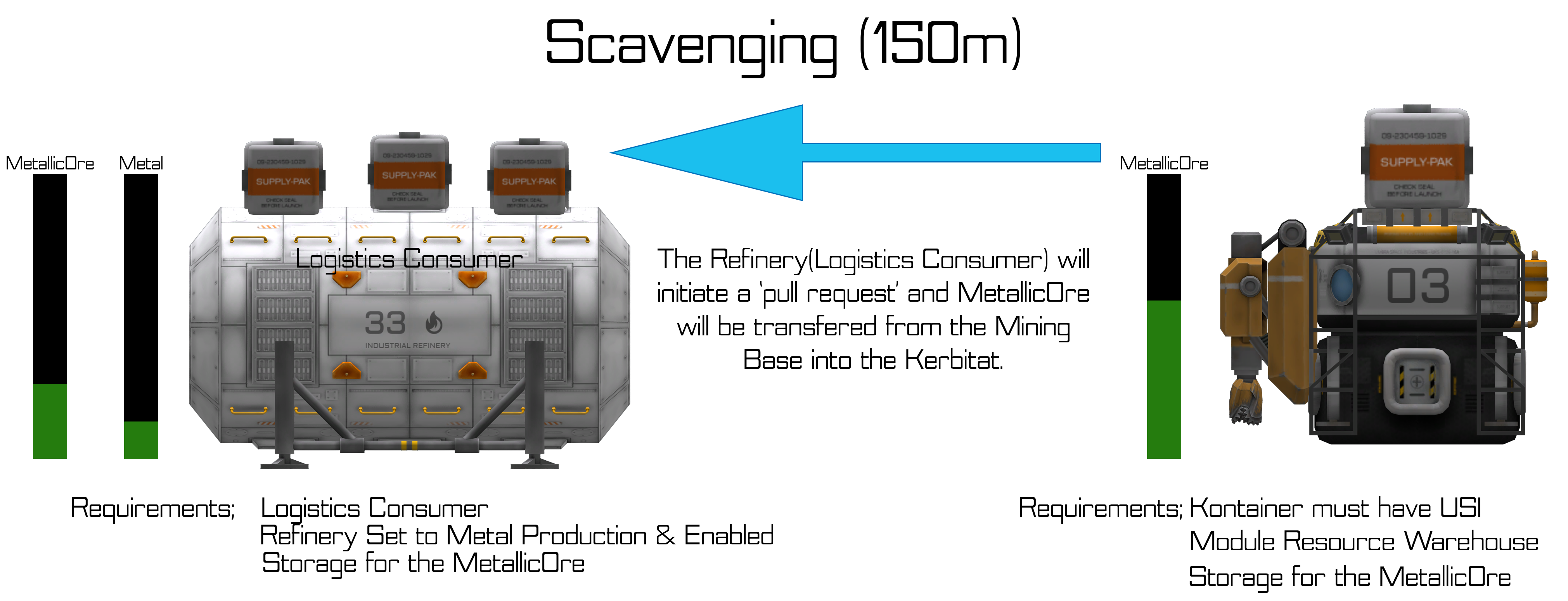-
Notifications
You must be signed in to change notification settings - Fork 151
Functions (Logistics)
Updated for 0.55.0
An illustrated version of the below guide is also available online or as an in-game help manual (requires KIS).
In MKS, Logistics is the process of moving things from one vessel (the Warehouse) to another (the Consumer). This can happen via many different methods each with their own ranges and requirements, but all logistics use the same basic mechanism. Regardless of the specific method's range, a few things must be true. The Consumer must have the LogisticsConsumer module, the Warehouse must have the ResourceWarehouse module, and they must be within range. Consumers will also only request resources if they are below 50%, will never request more than 10% of their capacity at a time, will never request Machinery, and will only request EC if they are hooked up into a proper Power Coupling/Distribution network.






Sometimes you need stuff from far away. Even without dedicated storage of their own, these vessels can relay resources between parts within range so long as they are piloted. Qualifying rover parts include the Karibou Expedition Rover cockpit, and the surface Pioneer Module.
Example: Your mining rig is over a kilometer away from your processing plant. Just toss a qualifying rover in range (150m) of both, and resources will flow automatically to the ship that needs them.

Sometimes the stuff you want is on the other side of the planet. And sometimes you make so much stuff that you run out of a place to put it. Planetary Logistics is like a giant warehouse shared by every vessel on the planet, and uses special warehouses that can tap into planetary storage (which is infinite!).
If a local storage has too much stuff - it's over half full - it puts some in the planetary warehouse. If it has too little, it pulls it out. There's a GUI where you can see how much stuff you have in the giant global warehouse.
A Logistics Module is required for the craft to take part, currently either the 'Duna' Logistics Center or the 'Tundra' Pioneer - Logistics Module. Resources can be 'pushed' to planetary storage without Crew provided a Logistics module or Material Processing Unit is present, but require a 'Pilot' or 'QuarterMaster' and a Logistics module to pull resources back out.
As of KSP 1.4.1 and MKS 0.55.0, a fourth logistics mechanic has been created: Orbital Logistics.
This mechanic allows transfers between vessels with a Logistics Module, whether they are grounded or in orbit, within a single sphere of influence (SOI). Of course this comes at a (steep) cost, in a new resource called Transport Credits.
In order to transport resources, you must first convert Liquid Fuel, Oxidizer, and Material Kits into Transport Credits at the rate of 5 TC = 1MK + 2.25 LF + 2.75 Ox. This process is performed in one of the Logistics Modules by clicking on "Start T-Credits".
Each transfer requires a certain amount of time to complete, which is based on the distance of the vehicles, and their ground-to-orbit relationship:
- Ground-to-ground transport is dependent upon the distance of the two vessels.
- Ground-to-orbit or orbit-to-ground takes into account the orbital period of the orbiting vessel and an average of 1.5 orbits to rendezvous with the ground vessel.
- Orbit-to-orbit also takes into account the orbital period of the vessels and assumes four (4) orbits to rendezvous. If the semi major axis of the vessels is similar, an additional two (2) orbits are added to account for transfer orbit maneuvers.
Additionally, time for docking, refueling and resource transfer is taken into account on both ends of the trip. The resource transfer time is calculated per tonne.
To schedule a transfer, click on "Orbital Logistics" in a Logistics Module's context menu, then select "New Transfer". The top of the New Transfer window shows the other logistics modules within the SOI. Use the arrow buttons to select one as the Destination, select the resources and amounts to transfer, and then schedule the job. All scheduled transfers can be viewed in the "Orbital Logistics" tab of the Kolonization Dashboard.
A chart is provided below listing all Resource Warehouses currently implemented, as well as if they possess additional functionality.
| Part | Planetary Logistics |
|---|---|
| Ranger ISM (Inflatable Storage Module) | X |
| Ranger Saddle Tank | X |
| MK-V Supply Redi-Pak | X |
| Tundra Nuclear Fuel Processor* | X |
| Nuclear Fuel Container | X |
| Nuclear Waste Container | X |
| Kontainer Tank (01.25m) | X |
| Kontainer Tank (02.5m) | X |
| Kontainer Tank (03.75m) | X |
| Kontainer Tank (05m) | X |
| Kontainer Tank - Round (all sizes) | X |
| Kontainer Tank - Cluster (all sizes) | X |
| Kontainer (01.25m) | X |
| Kontainer (02.5m) | X |
| Kontainer (03.75m) | X |
| Kontainer (05m) | X |
| Kontainer - Flat (all sizes) | X |
*=Logistics Consumer
Logistics Consumers are listed below. These are the only parts which can initiate a pull request.
- MK-V: 'Scout" Colony Pod, 'Koala' Colony Hub, Power-Pack, Sifter, Smelter, Workshop, Agriculture, Crusher,
- OKS: Aeroponics, Pioneer, Habitation Ring, Kerbitat, Workshop, Workspace
- MKS: Aeroponics, Pioneer, Kerbitat, PDU, Workspace
- Mk-III: Akademy, Fabricator, Nuclear Fuel Processor, Refinery, Sifter,
- MEU Drills, Light Globe
- Stock: Radial Drill, Fuel Cell Array, ISRU's
- All parts with command capabilities

Power is important too! Power distribution lets you send power from a "power distributor" (crewed by an engineer) to lots of vessels within range. Just like you need outlets in your house to plug your power cords into, vessels will need a power coupler to tap into your power distribution network. Example: rather than having separate power sources (RTGs, solar, etc.) for your smaller vessels around the base, just wire them into one giant power source (like a nuclear reactor) and save on part count!
The small Power Pack and Power Coupler will distribute (and receive) power within 500 meters, while the larger Power Distribution Unit and ad-hoc Microwave Power Transceiver will distribute (and receive) power within 2000 meters.
Power couplers are included in the following, which use the Power Distributor for their range unless noted:
- MkV: 'Scout' Command Pod & Power-Pack (500m)
- MK-III: Akademy, Fabricator, Nuclear Fuel Processor, Refiner, Sifter
- (Duna-Class) MKS: Aeroponics, Pioneer, Kerbitat, and PDU (2000m)
- Light Globe(250m), Microwave Power Transceiver (2000m)
- Stock Fuel Cell Array (500m)